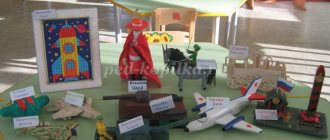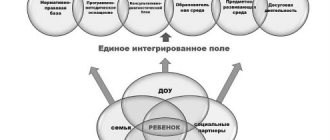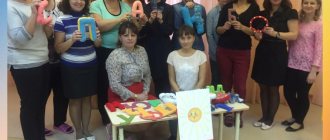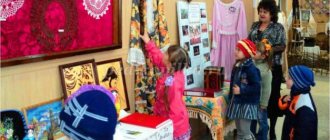“The development of the child as a whole, and not just the purity of his native speech, then, the entire intellectual development of the child and, finally, the development of character, emotional development - all this reflects the direct influence of speech.”
Lev Semyonovich Vygotsky
The Federal State Educational Standard for Preschool Education has defined target guidelines - the social and psychological characteristics of a child’s personality at the stage of completion of preschool education. Among which, speech occupies one of the central places as an independently formed function, namely: by the end of preschool education, a preschool education student understands oral speech well and can express his thoughts and desires.
Speech is also included as an important component, as a means of communication, cognition, creativity and other targets. Thus, none of the targets can be achieved without mastering speech culture. To achieve the GEF targets, systematic prevention and correction of speech disorders is necessary.
Preschool age is the most favorable for the development and formation of speech in children, and its deficiencies at this time are easier and faster to overcome. Speech activity that is defective for one reason or another has a negative impact on the formation of the child’s mental sphere and the development of his personal qualities.
First of all, defects in speech function lead to impaired or delayed development of higher mental functions mediated by speech: verbal memory, semantic memorization, auditory attention, verbal-logical thinking. This is reflected both in the productivity of mental operations and in the rate of development of cognitive activity. In addition, a speech defect leaves an imprint on the formation of a child’s personality and makes it difficult for him to communicate with adults and peers.
Objectives of speech development in the Federal State Educational Standard of Education
- mastering speech as a means of communication and culture (this means that it is necessary to form children’s oral speech at such a level that they do not experience difficulties in establishing contacts with peers and adults, so that their speech is understandable to others);
- enrichment of the active vocabulary (occurs at the expense of the preschooler’s main vocabulary fund and depends on our dictionary and the dictionary of the parents; to expand the vocabulary of children, favorable conditions are created with comprehensive thematic planning of work);
- development of coherent, grammatically correct dialogical and monologue speech (our coherent speech consists of two parts - dialogue and monologue. The building material for it is a dictionary and mastering the grammatical structure of speech, i.e. the ability to change words, combine them into sentences);
- development of speech creativity (the work is not easy, it assumes that children independently compose simple short stories, take part in composing poetic phrases, come up with new moves in the plot of a fairy tale, etc.). All this becomes possible if we create the conditions for it;
- acquaintance with book culture, children's literature, listening comprehension of texts of various genres of children's literature (The main problem is that the book has ceased to be a value in many families, children do not gain the experience of reading at home - listening, the book should become a companion for children);
- the formation of sound analytical-synthetic activity as a prerequisite for learning to read and write;
- development of sound and intonation culture, phonemic hearing (the child learns the stress system, pronunciation of words and the ability to speak expressively, read poetry).
One of the key places in the system of mastering speech culture by preschool children is occupied by a speech therapist teacher.
Basic documents regulating the tasks, content and forms of organization of the correctional pedagogical process in preschool educational institutions (for children with severe speech impairment):
Law of the Russian Federation “On Education” N 273-FZ;
Federal Law “On Special Education of Persons with Disabilities”;
Order of the Ministry of Education and Science of Russia dated October 17, 2013 N 1155 “On approval of the federal state educational standard for preschool education” (Registered with the Ministry of Justice of Russia on November 14, 2013 N 30384).
My activities in the correction of speech disorders are based on a traditional, classical program:
- System of correctional and developmental work in the speech therapy group of a kindergarten with general speech underdevelopment (4-7 years). Nishcheva N.V. St. Petersburg: 2007.
Every academic year, a primary speech therapy examination of children in the senior group is carried out according to O.B. Inshakova. Based on the results of the initial examination of the speech system, 12 children aged 5-6 years are recruited for classes with a speech therapist teacher and a plan of correctional and developmental work is drawn up for the entire school year.
When designing a correctional and developmental process, I take into account the following correctional and pedagogical principles:
- consistency;
- complexity;
- development principle;
- consideration of speech disorders in relation to other aspects of the child’s mental development;
- the principle of taking into account the structure of a speech defect;
- the principle of a workaround for correcting deficiencies in speech development;
- the principle of taking into account the zone of proximal and actual development.
In my opinion, for the successful implementation of the correctional educational process, the creation of a subject-development environment plays an important role: equipping the speech therapy room with the necessary equipment, didactic materials and visual aids. A subject environment with developmental components has been created in the classroom. Scientific and methodological support of the educational process has been systematized, speech therapy documentation is maintained, and an information block for teachers and parents operates.
The main organizational forms of speech therapy work were chosen:
– individual speech therapy work;
– subgroup speech therapy work, which is carried out within the framework of direct educational activities, directly organized activities, joint activities of the teacher and children.
All speech therapy work is carried out in the form of speech gymnastics, speech therapy training, communicative games, lexical and grammatical games, etc.
I consider the most acceptable methods in practical work to be explanatory and illustrative, reproductive, partly search, communicative, information and communication; methods of control, self-control and mutual control.
Also, in correctional work with children with speech impairments, I use the following health-saving technologies:
- articulation gymnastics,
- breathing exercises,
- finger and visual gymnastics,
- self-massage.
Correction of the speech system is impossible without the interaction of a speech therapist with teachers and parents. Therefore, I allocate a key place to this block of my activity. Work with parents is carried out in the following forms:
- speaking at parent meetings with reports on current work and its effectiveness;
- organizing individual conversations with parents, consultations on conducting speech exercises with children;
- conducting seminars and workshops;
- education through information stands in group locker rooms.
Work with educators is carried out through familiarization with the results of a speech therapy examination, speech therapy programs, and the tasks of correctional work for the school year; consultations on various topics.
For a more detailed analysis of my work, I suggest that you familiarize yourself with Table No. 1, which reflects all areas of the correctional and developmental process in the period from September 2022 to May 2022.
Table No. 1
| Month, year | correctional and developmental activities with children | interaction with teachers | interaction with parents |
| September 2020 | 1.Primary speech therapy examination of children of the middle, senior and preparatory groups. 2.Individual lessons according to an individual speech therapy support program 3. Subgroup logorhythmic lessons on the topics: “To speak clearly, you need to be friends with your fingers”; "Acquaintance with Tongue's House" | Familiarization of educators with the lists of children enrolled in speech therapy classes and the schedule. | Organizational meeting with parents of enrolled children (preparatory group). |
| October 2020 | 1.Individual lessons according to an individual speech therapy support program 2. Subgroup logorhythmic classes on the topics: “Vegetables. Adult labor in fields and gardens”; "Fruits. Labor of adults in gardens"; "Insects and Spiders"; " Migratory birds;. | Design of an interaction notebook. | 1.Designing a speech therapist’s corner on the topics: “Development of coherent speech in children” (preparatory group). 2.Individual consultations. |
| November 2020 | 1.Individual lessons according to an individual speech therapy support program 2. Subgroup lessons on lexical topics: “Berries and mushrooms. Forest in autumn”, “Pets”, “Wild animals of our forests”, “Clothes, shoes, hats”. | Consultations | Individual consultations. |
| December 2020 | 1.Individual lessons according to an individual speech therapy support program 2. Subgroup lessons on lexical topics: “Winter. Wintering birds", "Furniture", "Dishes", "New Year's holiday". | Seminar - workshop. | Design of a speech therapist's corner on the topics: “Articulation exercises” (preparatory group). |
| January 2021 | 1.Individual lessons according to an individual speech therapy support program 2. Subgroup lessons on lexical topics: “Transport”, “Professions”, “Work in the countryside in winter”. | Working with children according to the instructions of a speech therapist. | Individual consultations. |
| February 2021 | 1.Individual lessons according to an individual speech therapy support program 2. Subgroup lessons on lexical topics: “Tools of labor. Tools", "Defender of the Fatherland Day", "Animals of Hot Countries"; "Houseplants". | View GCD on speech development. | 1. Conversation “Enriching vocabulary” (preparatory group). 2.Individual consultations. |
| March 2021 | 1.Individual lessons according to an individual program. 2. Subgroup lessons on lexical topics: “Early spring. Mother’s holiday”, “Our Motherland-Russia”, “Moscow is the capital of Russia” | View GCD on speech development. | 1.Designing a speech therapist’s corner on the topics: “Children’s mastery of syllabic analysis of words” (preparatory group). 2.Individual consultations. |
| April 2021 | 1.Individual lessons according to an individual speech therapy support program 2. Subgroup lessons on lexical topics: “We read S.Ya. Marshak, K.I. Chukovsky, S.V. Mikhalkov, A.L. Barto" | Consolidation of acquired knowledge. Differentiation of delivered sounds. | 1. Questioning of parents whose children attended speech therapist classes. 2.Individual consultations. |
| May 2021 | 1.Individual lessons according to an individual plan. 2. Subgroup lessons on lexical topics: “Late spring. Insects in the spring”, “We read. A.S. Pushkin", "School. School supplies." | Filling out the performance table. | 1. Final parent meeting based on the results of the year. 2. Conversation “For those who go to school” (preparatory group). |
The final result depends on the severity of the speech disorder, on the child’s attitude towards his defect, on the general intellectual development of the child, on the parents’ understanding of the importance of correctional work and their participation in the correctional process.
By analyzing the final indicators of the speech development of children enrolled in classes with a speech therapist in the previous year, it is possible to identify positive dynamics in the development of speech culture.
The established system of work has a beneficial effect on improving children's speech. The leading role in speech development is played by an equipped developing subject-spatial environment. Correctional work with children, in turn, helps eliminate speech underdevelopment, which improves the development of all mental processes. It is also necessary to note that speech literacy helps children establish communication with peers and adults. It is important to remember that a necessary condition for positive dynamics is the education of parents in matters of correction of speech development.
Summarizing the above, we can conclude that in our preschool educational institution the necessary psychological and pedagogical conditions have been created for the full speech development of preschool children, but despite this, we continue to work on the formation and development of children’s speech.
Generalization of the work experience of a speech therapist teacher
Laces, fasteners, buttons, zippers.
In everyday life we often come across these objects. A child's hands are not yet developed enough to manipulate them with ease. You need to train everywhere and always on everything that can be tied, fastened, laced, and in no case should you be upset if it doesn’t work out the first time. You need more patience, attention, endurance.
Lacing develops sensorimotor coordination and fine motor skills; - develop spatial orientation, promote understanding of the concepts “above”, “below”, “right”, “left”; - develop lacing skills (lacing, tying a lace into a bow); - promote speech development; - develop creative abilities.
Laying out letters from various materials
is
a serious task. It requires perseverance and patience from children, and develops the skill of performing an action according to a given pattern. The lesson can be divided into several stages. First, the adult lays out or draws a sample letter on paper and introduces it to the child. Then the child copies a letter from the material provided. The next stage is when the student, with the help of an adult, lays out simple words and learns to read. I use mosaics, seeds, small nuts, buttons, pieces of paper, counting sticks, and wire for the lesson. Children use wire to make elements of letters, and then the letters themselves. This type of work captivates not only children, but also older children.
Broken applique . This method is accessible to the youngest children, as it does not require special technical skills. But older children also enjoy using this technique to convey the peculiarities of the texture of the image (fluffy chicken, shaggy bear cub). In this case, we tear the paper into pieces and make an image. Children can complicate the technique: not just tear as best they can, but pluck or tear off the contour pattern with more subtle and targeted movements.
When eliminating the prerequisites for optical dysgraphia, in parallel with the development of spatial representations, visual analysis and synthesis, I work on the speech designations of these relationships: on the understanding and use of prepositional constructions and adverbs. I also spend a lot of time working on clarifying and differentiating the optical images of mixed letters. For better assimilation, we correlate them with any similar objects and images
When introducing a new letter, I always talk about the correct articulation for pronouncing this sound, we highlight this sound among other sounds. After that, I introduce you to the visual image of the letter itself and together we select letters that have similar elements. For example, “This letter has no angle, that’s why it’s round” (This is the letter O, there is a common element with the letter Y, and if we remove part of the letter O, we will see the letter C, etc.). In my classes I use various riddles about letters, feeling relief letters and recognizing them, constructing from elements, reconstructing, copying from a sample, finding letters in noisy and superimposed images.
MAGAZINE Preschooler.RF
From the experience of work “Interaction of educators with a speech therapist teacher”Prepared by the teacher of the preparatory group for school: Olga Vitalievna Smirnova
I work as a teacher in a pre-school group, my work is based on close contact with the teacher - speech therapist.
At the beginning of the school year, a specialist acquaints teachers with the results of an examination of children’s speech. We fill out a table on children's sound pronunciation, which reflects the level of speech development and the state of speech sound culture. This table is included in the group's work program.
Throughout the year, we keep maps of each child’s individual development. “speech development” section together with the speech therapist. Based on development indicators, we draw up an individual route for each child, which includes work on speech development. Together with a specialist, we discuss a long-term plan and clarify the most rational methods of speech correction for each child.
We use the following methods and forms of work with children who have problems in speech development:
- daily articulation exercises;
- logochas (syllable exercises, inventing phrases, memorizing tongue twisters, poems, proverbs);
- individual lessons with children, which are aimed at automating already established sounds (pronouncing syllables, words, phrases, memorizing poems).
Articulatory gymnastics helps to develop clear and coordinated movements of the organs of the articulatory apparatus. The group has a card index of articulatory gymnastics, mirrors, pictures and diagrams.
Logo hour - includes reinforcing sounds, pronouncing tongue twisters, tongue twisters, syllable exercises, word games, breathing exercises to develop proper breathing, games to enrich the vocabulary, games to develop a sense of rhythm.
In the morning, while walking, during routine moments we use:
- games for the development of phonemic hearing and phonemic perception ( “Find the first and last sound” , “Clap or walk the word” , “Catch the sound” , “Parrot” , “Pick up the word” , “On the contrary” , “Say the words in pairs” );
- on the development of the lexical side of speech (enrichment and activation of children’s vocabulary) ( “Guess and name” , “Housewarming” , “I know five ...” , “The cat is the opposite” , “Say it differently” , “Family of words” );
- to develop and improve the sound culture of speech ( “Catch the word” , “Finish the phrase” , to automate the sound in speech we memorize phrases and poems);
- on the development of the grammatical side of speech - to exercise the ability to form different forms of the same word ( "Greedy" , "Dwarves and Giants" to coordinate different parts of speech in gender, number and case),
Interaction with a speech therapist makes it possible to:
- mutually attend directly organized educational activities with children,
- correctly plan educational activities to consolidate material in different types of children’s activities,
- jointly prepare children for all children's holidays, because The speech therapist, taking into account the children’s capabilities, selects and corrects speech material, determines the level of difficulty, gives recommendations to teachers, helps in memorizing poems and roles with children,
The work of a teacher and the work of a speech therapist are different. The main difference: a speech therapist corrects speech disorders, and we, under the guidance of a speech therapist, actively participate in the automation of sounds, the development of vocabulary and grammar, and coherent speech. During routine moments, we control the children’s pronunciation of already assigned sounds.
In our work, we use the principle of consistency and interconnection of educational material, its accessibility, which has a positive effect on the quality of speech development of children in our group.
To prevent dysgraphia in children with speech disorders, together with a speech therapist, we use finger games, graphic simulators, graphic dictations, games “Looking at the letters in the mirror” , noisy pictures “Letters mixed up” , shading letters, sculpting letters from plasticine, cutting out letters, graphic dictations .
In accordance with the lexical topics of the week, we select finger exercises with poetry. To make it more interesting, we include game objects (rubber band, pencil, ball) in finger games. We systematically organize productive activities using the Origami technique, which provides good training for the fingers, promotes the development of hand movements, and develops the accuracy of small finger movements. Origami is an activity that uses both hands at the same time.
Children enjoy traveling through the labyrinths. Maze games are fun and not only teach your child to focus on a task, but also develop gross motor skills (hand and forearm movements). When completing tasks, you need to make sure that the position of the hand changes, and not the sheet with tasks. For children who have noticeable fine motor skills impairments, I suggest collecting mosaics, puzzles, and construction sets. If the fingers develop, then thinking and speech will develop. Graphic dictations promote orientation in space, reinforce the concepts of top, bottom, right, left, and develop visual perception and auditory attention.
The speech therapist teacher helps us in our work: conducts directly organized educational activities for teaching literacy, selects literature, speech material, didactic games, articulation and finger gymnastics for us. I help by creating interactive games for differentiating sounds, composing complex sentences, learning the syllabic structure of words, and reinforcing sounds and letters.
The specialist conducts consultations, master classes, and workshops for teachers, in which he introduces speech games for children of different ages, literature on this topic, and improves our ability to correctly use methods and techniques for the development of children’s speech.
It is necessary to note another important area in the joint work of a speech therapist and a teacher - the relationship with parents. We provide consultations for parents, prepare moving folders, and prepare joint parent-teacher meetings. Each child attending a speech center has a notebook for individual work, which is led by a speech therapist and which both group teachers and parents have the opportunity to study.
We work with children throughout the day, having the opportunity to repeatedly repeat speech material, repeat and reinforce new words, without which their introduction into the child’s independent speech cannot occur. Thanks to the relationship between a speech therapist and a teacher, it is possible to more effectively correct speech defects and prepare the child for school.
| Next > |





